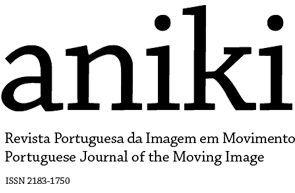Photography of poetry: becomings of fabulation, expanding durations and instantaneous movements
Abstract
The passing of time in Alessandra Sanguinetti's photographs refer to aspects of the moving image if we assume its inherent qualities of change and duration. Those are images of an encounter between cinema and photography which contaminate each other reciprocally with its own processes by expanding towards each other. There is a real durational quality that comes from the referent (the daily life of the photographed characters) which turns up into fabulation giving access to other beings and other specificities of time, all of them living in the image. That is the realm of the imaginary documentary in which images evoke bifurcations, take shape and gain movement inasmuch as they cease to allude to a given and objective notion of the real referring rather to a broader notion of time as indeterminate forms of duration. The ten years that goes by during the photographic essay 'The adventures of Guille and Belinda and The enigmatic meaning of their dreams' appears therefore to be shot in a single afternoon. The durations and becomings in the passage from the characters childhoods to their adult lives - or from a superficial game to an intense performative encounter with theirselves and Sanguinetti - are based in a free indirect speech form. This particular photographic fashion of the free indirect speech comes to light by the means of apparatuses, understood in a broad sense. Those apparatuses guide the photographic and relational processes leading to the creation of slits between objectivity and subjectivity that ultimately act in order to favor temporal and immaterial aspects in the images.References
AGAMBEN, Giogio. Notes on Gesture. In: Means Without Ends: Notes on Politics. Tradução de Vincenzo Binetti e Cesare Casarino. Minneapolis: University of Minnesota Press, 2000.
BARTHES, Roland. A Câmara Clara: nota sobre a fotografia. Rio de Janeiro: Nova Fronteira, 1984.
BERGSON, Henri. Evolução criadora. São Paulo: Martins Fontes, 2005
______. Matéria e memória: ensaio sobre a relação do corpo com o espírito. São Paulo: Martins Fontes, 1999.
BRASIL, André. Formas de vida na imagem: da indeterminação à inconstância. Revista Famecos. Porto Alegre, v. 17, n. 3, pp. 190-198, setembro/dezembro, 2010.
BAZIN, André. Théâtre et cinéma. In. Qu’est-ce que le cinéma?- II Le cinéma et les autres arts. Paris: Ed. Du CERF, 1959.
COHEN, Renato. Performance como linguagem: criação de um tempo-espaço de experimentação. São Paulo: Editora Perspectiva, 2002
CHIODETTO, Eder. Texto de curadoria da exposição coletiva Documental Imaginário. Rio de Janeiro: Oi Futuro Flamengo, 2012.
CLIFFORD, James. A Experiência Etnográfica: Antropologia e Literatura no Século XX. Rio de Janeiro: Editora UFRJ, 2011.
DELEUZE, Gilles; GUATTARI, Félix. O que é a filosofia? São Paulo: Editora 34, 2007.
DELEUZE, Gilles. Crítica e clínica. São Paulo: Editora 34, 1997.
______. O que é o dispositivo. In: O mistério de Ariana. Lisboa: ed. Vega, 1996.
______. Imagem-movimento: cinema I. Sao Paulo: Brasiliense, 1983.
______. Imagem-tempo: cinema II. Sao Paulo: Brasiliense, 1990.
FOUCAULT, Michel. A arqueologia do saber. Rio de Janeiro: Forense Universitária, 2004.
FERNÁNDEZ, Horacio. Folheto da Exposição Fotolivros Latino-Americanos. Rio de Janeiro: IMS, 2013.
GOFFMAN, E. A representação do eu na vida cotidiana. Rio de Janeiro: Vozes, 2004
LISSOVSKY, Maurício. Máquina de esperar: origem e estética da fotografia moderna. Rio de Janeiro: Mauad X, 2008.
MALRAUX, André. Le Musée Imaginaire [1947]. Paris: Gallimard, 1965.
MIGLIORIN, Cezar. O Dispositivo como estratégia narrativa. Revista acadêmica de cinema, n.3, Rio de Janeiro: Estácio de Sá. ONLINE, 2005.
NIETZSCHE, Friedrich. Vontade de poder. Rio de Janeiro: Contaponto, 2008.
OITICICA, Hélio. “Cosmococa by Neville D´Almeida”, 24/junho/1973. Reproduzido em Cosmococa Program in Progress. Projeto Hélio Oiticica, Fundación Eduardo F. Constantini, Centro de Arte Contemporânea Inhotim, catálogo da exposição realizada em 2005 no MALBA – Buenos Aires, p.62- 63.
PARENTE, André. Narrativa e modernidade: Os cinemas não-narrativos do pós guerra. Campinas: Papirus, 1994.
______. Cinema de exposição: o dispositivo em contracampo. Revista Poiésis, n. 12, p. 51-63, nov. 2008.
______. Cinema em trânsito. Rio de Janeiro: Beco do Azougue, 2011.
PASOLINI, Pier Paolo. The cinema of poetry. In. NICHOLS, Bill. Movies and Methods: An Anthology. CA: University of California Press, 1976.
PIMENTEL, Mariana Rodrigues. Fabulação: a memória do futuro. Tese de doutorado (Letras). Or.: Karl Erik Schollhammer. Pontifícia Universidade Católica, Rio de Janeiro, 2010.
SANGUINETTI, Alessandra. The adventures of Guille and Belinda and The Enigmatic Meaning of their Dreams. Portland: Nazraeli Press, 2010.
______. The Adventures of Guille and Belinda and the Enigmatic Meaning of Their Dreams. In: Light Work: Contact Sheet 120, 2003.
SHOWALTER, Elaine. Representing Ophelia: Women, Madness, and the Responsibilities of Feminist Criticism. In: Shakespeare and the Question of Theory, edited by Patricia Parker and Geoffrey Hartman, Methuen, 1985, pp. 77-94.





